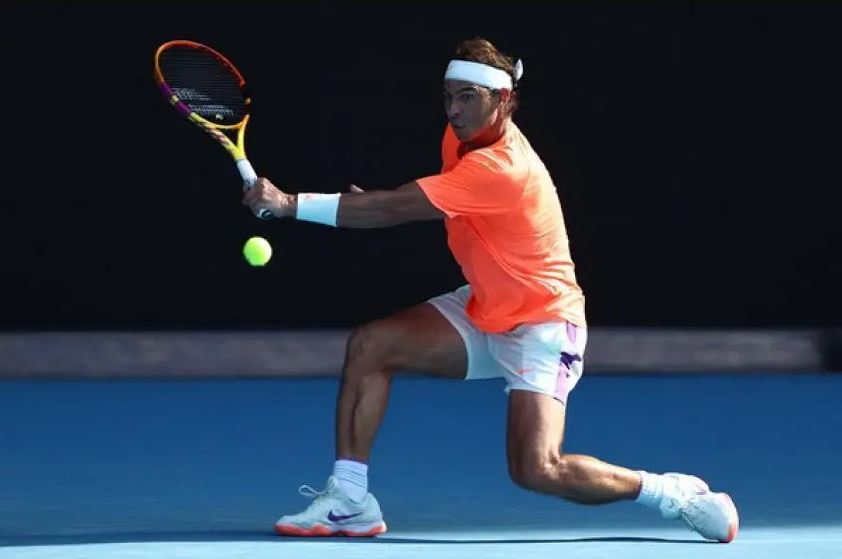Rafael Nadal Net Worth: A Tennis Legend’s Journey -Rafael Nadal, a Spanish professional tennis player who is known as the “King of Clay,” has made an impression on the sports industry. He has solidified his status as one of the best tennis players of all time with his incredible career, both on and off the court. Rafael Nadal’s journey has been characterised by persistence, determination, and unparalleled accomplishment, as evidenced by his net worth, early years, remarkable career, personal life, scandals, and other accomplishments.
Table of Contents
Rafael Nadal Net Worth
| Nickname: | King of clay |
| Real Name: | Rafael Nadal Parera |
| Net Worth: | $220 million |
| Birthplace: | Manacor, Mallorca, Spain |
| Weight: | 85 kg |
| Sexual Orientation: | Straight |
| Marital Status: | Married |
| Spouse: | Maria Francisca Perello |
| Children: | Rafael Nadal Perello |
| Girlfriend: | None |
| Date of Birth: | June 3, 1986 |
| Gender: | Male |
| Height: | 1.85 m |
| Profession: | Tennis player |
| Nationality: | Spanish |
| Source of Wealth: | Tennis |
| Education: | N/A |
| Father: | Sebastián Nadal |
| Mother: | Ana María Parera |
| Brother: | None |
| Sister: | María Isabel Nadal |

Early years
On June 3, 1986, Rafael Nadal Parera was born in Manacor, Mallorca, Spain. Coached by his uncle Toni Nadal, a former professional tennis player who recognised his talent, he started his athletic journey at a young age. Under the tutelage of his uncle, Nadal started practicing at the age of three and displayed remarkable talent almost away. At the age of eight, Nadal was already winning under-12 tennis competitions. He was also a promising football player. He was forced to transfer for professional training, but his family’s unwavering support allowed him to continue developing in Mallorca, his native country.
RELATED: Toto Wolff Net Worth: A Billionaire Motorsport Mogul
Career
Rafael Nadal, unlike most of his peers, began his professional tennis career at the age of 14 in 2001. After turning 16, he participated in just two ITF Junior Circuit events. Nadal showed his talent by making it to the Wimbledon junior singles semifinals and assisting Spain in winning the Junior Davis Cup, despite having less junior experience. At last, he achieved a career-high rating of world No. 145 in junior singles.
Early in2001, Nadal entered professional tournament qualifying stages, but he had difficulty making it to the main event. In September 2001, he made his main draw debut as a professional at the Futures in Madrid. Nadal steadily rose in the rankings over the course of the following year, accomplishing important firsts like winning his first ATP match and cracking the top 100 before turning sixteen. At fifteen years and ten months old, he won his first ATP match in 2002, being Open Era history’s ninth player to do so before turning sixteen. With his several Challenger victories and notable performances in ATP tournaments, including a wildcard entry into the Wimbledon semifinals, Rafael Nadal’s career took off.
In 2005, Rafael Nadal had a breakthrough year as he won three Masters titles, his first Grand Slam at the French Open, and dominated the clay-court season. In the semifinals, he defeated Roger Federer to become just the second player in history to win the French Open in his debut. After his victory, Rafael Nadal entered the top 10 for the first time in his career. He then went on to win 11 singles titles and the ATP Most Improved Player of the Year award, dominating on both clay and hard courts throughout the year.

2006
Rafael Nadal suffered a foot injury in 2006 that kept him out of the Australian Open, but he made a comeback in February. He didn’t win the Open 13 tournament in Marseille, but he still left a lasting impression when he beat Roger Federer in the Dubai Open final, ending Federer’s 56-match winning streak on hard courts. Nevertheless, Nadal lost both the Miami Masters second round and the Indian Wells Masters semifinals.
Nadal was unstoppable on clay, taking home the four titles and setting a record of twenty-four straight wins. In the Monte Carlo Masters final, the Torneo Godó in Barcelona, and the Italian Open final, he defeated Roger Federer. Notably, he preserved two match chances to defeat Federer in the Italian Open final, which marked a turning point in their rivalry. In addition, Nadal broke Guillermo Vilas’ 29-year streak of unbroken clay-court victories. He joined Björn Borg as the only men to win three consecutive Roland Garros titles since 1914 when he defeated Roger Federer in the French Open final.
During the Artois Championship quarterfinals at the Queen’s Club in London, Rafael Nadal sustained another injury, this time to his shoulder. He made it to the Wimbledon final for the first time in spite of this loss, where he faced Federer in a highly anticipated match. Even though Federer prevailed in the end, Nadal’s heroic battle is regarded as one of the best matches in tennis history. Nadal moved up to the No. 2 slot for the second straight year thanks to his outstanding play throughout the year.
2007-2009
Nadal faced more challenges in 2007, losing in the quarterfinals of both the Dubai Tennis Championships and the Australian Open. He was successful on clay, making it to the Hamburg Masters final and taking home three Masters trophies. After winning the French Open three times in a row, Rafael Nadal matched Björn Borg’s record. For the third consecutive year, he too made it to the Wimbledon final, but Federer defeated him in a thrilling match.
During the spring clay-court season in 2008, Rafael Nadal won four singles titles, including the French Open. After that, he triumphed in his maiden Wimbledon tournament, beating Roger Federer in an amazing final. Nadal’s victory made him just the third person in Open Era history to win Wimbledon and the French Open in the same year. In addition, he ended Roger Federer’s lengthy reign at the top of the world rankings by winning the gold medal in the Olympics in Beijing. Despite injuries at the end of the year, Rafael Nadal’s outstanding accomplishments cemented his status as one of the greatest tennis players of all time.
In 2009, Rafael Nadal won his maiden hard-court major singles match at the Australian Open. In the process, he ended Roger Federer’s 56-match winning streak on hard courts by defeating Federer in the championship match. Nadal dominated the European clay-court season despite a few minor setbacks. He won all four championships and defeated Roger Federer in the Monte Carlo Masters, Torneo Godó, and Italian Open finals. He also surpassed Guillermo Vilas’ record of victories on clay courts in a row. Then, Nadal advanced to his first Wimbledon final but fell short against Federer. He was defeated in the US Open quarterfinals. Nadal came in second in the world rankings for the second consecutive year.
2010-2013
When Nadal won the US Open in 2010, he completed his career Grand Slam and became the second male player to do it. In addition, he won the Monte-Carlo Masters for six consecutive years, Wimbledon for two, and the French Open for five times. Nadal achieved his first year-end #1 ranking when he concluded the year as the World No. 1 player.
2011 saw Nadal win his sixth French Open title, but he lost to Djokovic in the Wimbledon final, ending his 20-match winning streak at the tournament. His play was hindered by a number of maladies he had throughout the year, including foot and hamstring problems. He assisted Spain in winning the Davis Cup and advancing to the US Open final despite setbacks.
After defeating Djokovic in the championship match, Rafael Nadal captured his eighth French Open title in 2012. He was victorious in both the Italian Open and the Monte-Carlo Masters. He was forced to withdraw from the Olympics and the remainder of the season due to knee irritation after losing to Lukáš Rosol in the second round of Wimbledon. As the year came to an end, Nadal’s world ranking of fourth was his highest since eight years ago.
2013 saw Rafael Nadal’s incredible comeback from an injury. Due to a stomach ailment, he had to withdraw from the Australian Open, but he returned to win the Brasil Open and the VTR Open in Chile. Then he easily defeated David Ferrer in the Abierto Mexicano Telcel. At the Indian Wells Masters, Rafael Nadal continued his winning streak, defeating top players like Juan Martín del Potro and Roger Federer.
2013-2015
After losing to Djokovic at the Monte-Carlo Masters, he bounced back to win the Barcelona Open and the Madrid Open, which elevated him to the No. 4 position. The pinnacle of Nadal’s season was achieved at the French Open, when he broke records and solidified his dominance on clay courts by winning his eighth championship.
Nevertheless, he unexpectedly lost to Steve Darcis in the opening round at Wimbledon. After a setback, Rafael Nadal triumphed in the US Open, Montreal Masters, and Cincinnati Masters to complete the Summer Slam. Also, he assisted Spain in making it to the World Group Playoffs for the Davis Cup. Nadal advanced to the ATP Finals and secured the top spot at the conclusion of the year despite losing to Djokovic in the China Open final.
Nadal had a successful start to the 2014 season when he defeated Stanislas Wawrinka in the Australian Open final, but his performance was hindered by a back issue. Although he was eliminated early in Indian Wells and Miami, he won the first Rio Open. With defeats in the Monte-Carlo Masters and the Barcelona Open, but victories at the Madrid Open, Nadal’s clay court season was uneventful. He tied Pete Sampras’ record for the most Grand Slam victories with his tenth French Open victory, but injury caused him to leave early from the US Open and Wimbledon.
Nadal struggled with form and injuries in 2015. In the Australian Open, Rio Open, and Miami Open, he was ousted in the first round. Nadal suffered defeats at the Madrid Open, Barcelona Open, and Monte Carlo Masters despite winning the Argentina Open. His record stretch came to an end when he lost to Djokovic in the quarterfinals of the French Open. Nadal continued to struggle on grass, losing matches at Wimbledon and the Aegon Championships.
2016-2019
Nadal faced more challenges in 2016, having to withdraw early from Wimbledon and the Australian Open due to injuries. He lost the Madrid Open and the Italian Open, but he triumphed in the Mubadala Championship and the Monte Carlo Masters. During his time competing for Spain at the Rio Olympics, Rafael Nadal reached the bronze medal match in singles and won gold in men’s doubles. He had to miss the entire season to heal a wrist injury.
Nadal made an incredible comeback and reclaimed his top spot in the world in 2017. He advanced to the Australian Open final, when Roger Federer defeated him. At the Madrid Open, Barcelona Open, and Monte Carlo Masters, Rafael Nadal won. He achieved a record-tying eighth French Open victory, increasing his Grand Slam tally to fifteen. Nadal returned to win the US Open, his third title in the tournament, despite leaving Wimbledon early. He broke records by taking back the top rank at year’s conclusion.
2020-present
With his 13th French Open victory in 2020, Rafael Nadal tied Roger Federer’s record of 20 Grand Slam victories. His performance was strong throughout the entire year, even with setbacks and injuries.
Due to health issues in 2021, Rafael Nadal had to quit early from tournaments including the Australian Open and the French Open. In spite of this, he won titles at the Italian Open and the Barcelona Open before an injury to his foot ended his season.
In2022, Rafael Nadal made a triumphant comeback, taking home the Australian Open title and his 21st Grand Slam victory. Among his other noteworthy accomplishments was becoming the second player in the Open Era to complete a double Career Grand Slam. But later in the season, he suffered from injuries that affected his play at the US Open and Wimbledon.
Due to health issues in 2023, Rafael Nadal was forced to leave the top 100 rankings for the first time in twenty years. He left out of several competitions, including Grand Slams, and he made mention of retiring in 2024.
Nadal made a comeback to the ATP circuit in 2024, but at the Brisbane International, he sustained a muscular injury. He still competes, though, with the goal of taking part in exhibition events like the Netflix Slam.

Business Ventures
He has amassed a financial empire thanks to astute investments, lucrative endorsement deals, and consistent success on the tennis court. His annual income from endorsements, appearance fees, and tournament winnings exceeds $40 million. His career earnings (wins plus endorsements) topped $500 million in June 2020, making him one of the wealthiest athletes in the world.
Personal Life
2019 saw Nadal wed his longtime partner Xisca Perelló in a private ceremony on the Spanish island of Mallorca. Their son has been welcomed. Throughout his career, Rafael Nadal has found strength and support in his connection with Perelló, who is often seen supporting him from the stands.
Awards and Achievements
Over the course of his career, Rafael Nadal has received numerous honours, including the ITF World Championship five times in 2008, 2010, 2017, 2019, and 2022. In addition, he has won five times as the ATP Player of the Year: in 2008, 2010, 2013, 2017, and 2019.
The Laureus World Sports Award for Breakthrough of the Year in 2006, Sportsman of the Year in 2011 and 2021, and Comeback of the Year in 2014 are among his other notable accolades. In addition, Nadal has received five Stefan Edberg Sportsmanship Awards: in 2010, 2018, 2019, 2020, and 2021. He has also won the ATP Newcomer of the Year in 2003, the BBC Sports Personality World Sport Star of the Year in 2010, the ATP Most Improved Player of the Year in 2005, and the ATP Newcomer of the Year in 2010.
In addition, he received the ATP Fan’s Favourite Award in 2022, the ATP Arthur Ashe Humanitarian of the Year Award in 2011, and the ATP Comeback Player of the Year Award in 2013.
Conclusion
It is truly amazing how Rafael Nadal went from being a budding tennis star in Mallorca to being a tennis superstar with 20 Grand Slam victories. Beyond the realm of sports, his influence inspires millions of people globally. In the world of tennis, Rafael Nadal is still regarded as a model of greatness and tenacity.









Leave a Comment